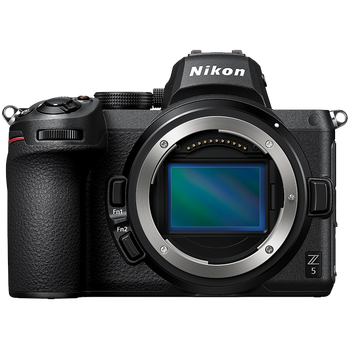- Exceptional image quality
- 8K video recording
- Fast and accurate autofocus
- Affordable full-frame option
- High-quality images
- Stabilized photos and videos
- User-friendly design
- Lightweight and portable
- High price
- Large file sizes
- Limited continuous shooting speed
- Crop in 4K video
Canon EOS R5 vs Nikon Z5
The world of photography has witnessed a significant shift towards mirrorless cameras, offering unparalleled flexibility, speed, and image quality. Two prominent contenders in this realm are the Canon EOS R5 and the Nikon Z5. Both cameras have garnered attention for their exceptional features, but which one stands out as the better choice? In this comparison, we'll delve into the details of these two mirrorless cameras to help you make an informed decision.
Sensor and Image Quality
The Canon EOS R5 boasts a 45-megapixel full-frame CMOS sensor, capable of capturing stunning images with exceptional detail and color accuracy. The Nikon Z5, on the other hand, features a 24.3-megapixel full-frame CMOS sensor, which still delivers impressive image quality but may not quite match the EOS R5's resolution.
In terms of image processing, both cameras utilize advanced processors – the Canon EOS R5 uses the DIGIC X processor, while the Nikon Z5 employs the EXPEED 6 processor. Both processors provide fast and efficient image processing, but the DIGIC X processor in the EOS R5 offers more advanced features like improved noise reduction and enhanced color grading.
Autofocus and Speed
Both cameras feature advanced autofocus systems, but the Canon EOS R5 has a slight edge with its 5,940-point phase-detection AF system. This allows for incredibly fast and accurate subject tracking, making it ideal for capturing high-speed action sequences or wildlife photography. The Nikon Z5's 273-point phase-detection AF system is still impressive, but may not quite match the EOS R5's speed and accuracy.
In terms of burst mode shooting, the Canon EOS R5 can capture up to 20 frames per second (fps) with its electronic shutter, while the Nikon Z5 tops out at 4.5 fps with its mechanical shutter. However, the Z5 can shoot up to 9 fps with its electronic shutter, which is still respectable but not quite as fast as the EOS R5.
Video Capabilities
Both cameras are capable of capturing stunning video footage, but the Canon EOS R5 has a few advantages in this department. It can record 8K video at 30p, while the Nikon Z5 tops out at 4K video at 30p. The EOS R5 also features more advanced video features like 10-bit 4:2:2 color output and Canon's proprietary Log profile for enhanced color grading.
Ergonomics and Build Quality
Both cameras feature rugged and weather-sealed designs, but the Canon EOS R5 has a slightly more premium feel to it. The EOS R5's body is constructed from magnesium alloy, while the Nikon Z5 uses a combination of magnesium alloy and polycarbonate. The EOS R5 also features a more comprehensive control layout, with dedicated buttons for ISO, white balance, and autofocus mode.
Lenses and Compatibility
Both cameras use their respective manufacturer's mirrorless lens mounts – the Canon RF mount for the EOS R5 and the Nikon Z mount for the Z5. While both mounts offer a range of high-quality lenses, the Canon RF mount has a more established ecosystem with a wider selection of native lenses available.
Conclusion
In conclusion, both the Canon EOS R5 and the Nikon Z5 are exceptional mirrorless cameras that cater to different needs and preferences. The Canon EOS R5 stands out for its high-resolution sensor, advanced autofocus system, and impressive video capabilities, making it an ideal choice for professional photographers and videographers.
The Nikon Z5, on the other hand, offers a more affordable entry point into the world of full-frame mirrorless cameras, with a still-impressive 24.3-megapixel sensor and advanced features like in-body image stabilization. While it may not quite match the EOS R5's performance, the Z5 is an excellent option for enthusiasts and hobbyists looking to upgrade from crop-sensor or older DSLR systems.
Ultimately, the choice between these two mirrorless cameras will depend on your specific needs, budget, and preferences. If you're willing to invest in a high-end camera with cutting-edge features, the Canon EOS R5 is an excellent choice. However, if you're looking for a more affordable entry point into the world of full-frame mirrorless photography, the Nikon Z5 is definitely worth considering.

































